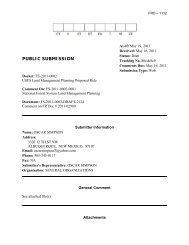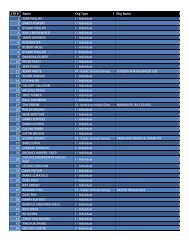FRD â0638 Attributes Comments - Content Analysis Group, LLC
FRD â0638 Attributes Comments - Content Analysis Group, LLC
FRD â0638 Attributes Comments - Content Analysis Group, LLC
Create successful ePaper yourself
Turn your PDF publications into a flip-book with our unique Google optimized e-Paper software.
<strong>FRD</strong> –0638<br />
Sustainability. The Proposed Rule does not properly address the various multiple uses the Forest Service is required to<br />
manage for under the Multiple Use-Sustained Yield Act. Under Sec. 219.8 (b) Social and economic sustainability it states,<br />
"The plan must include plan components to guide the unit's contribution to social and economic sustainability…" , effectively<br />
placing ecological sustainability above the social and economic components. The language "contribution" renders the social<br />
and economic sustainability as secondary status and delivers the wrong message to the Forest Service about what they need<br />
to be doing managing natural resources such as timber, mining, and grazing. The Proposed Rule needs to recognize this and<br />
include language for plan components that maintain or restore all three elements of sustainability; ecological, social, and<br />
economical. Alternative C is the right approach.<br />
Role of Science. "Best available science" is identified throughout the Proposed Rules. Sec 219.3 "The responsible official shall<br />
take into account the best available scientific information throughout the planning process" seems relatively harmless. Having<br />
accurate, reliable and relevant information is crucial in Forest Service decision making and implementation, however, proving<br />
what science is "best" is likely to be time consuming and of little value, but will undoubtedly lead to lawsuits. Replace<br />
proposed Sec. 219.3 with the language in Alternative C.<br />
Public Participation. The public participation involvement process (Sec 219.4) is quite detailed and cumbersome and<br />
downplays the current requirement to coordinate with local government. NEPA requires that the analysis conducted be<br />
coordinated with local governments. The call for greater "public input" weakens the existing requirement to coordinate forest<br />
planning with local governments and their plans. Public involvement from all walks of life should be encouraged, but the local<br />
citizens and forest users that are most directly affected by the plan should have a greater influence on the future<br />
management decisions since they are the ones who live, work, play, and enjoy their adjacent federal lands each and every<br />
day. Too much emphasis is placed on using "contemporary tools" to engage the public and not enough emphasis given to the<br />
people who have to live with management decisions (or lack of) that may have great economic, social, and ecological<br />
impacts. Public outreach should be left to the discretion of the responsible official. See Alternative C.<br />
Process and Planning. The Proposed Rule places too much focus on planning, monitoring and assessing and not enough on<br />
objectives and desired future conditions (Sec. 219.5, 219.6, 219.7). These planning requirements are too time consuming<br />
and costly to implement considering the scarce resources and personnel availability. The goal of forest planning should be<br />
timely and efficient completion and implementation of plans, not endless planning. The process is not likely to improve our<br />
forests or make them easier to manage. We need to develop a strategy to make planning faster, simpler, less expensive as<br />
well as staying out of the court systems. Forest plans should be completed within three years of initiation, though the average<br />
10 year plan has taken 7-10 years to implement. The Proposed Rule adds additional levels of process that can only cause<br />
continued damage to our national forests. Only those processes required by Congress in the NFMA should be included in the<br />
Planning Rule.<br />
Assessments. The establishment of a new layer of planning identified in Sec 219.6 which would be prepared apart from the<br />
Forest Plan without NEPA analysis is a violation of the current law. This is another unnecessary process in the planning phase.<br />
I recommend eliminating Sec 219.6 and its requirements.<br />
Monitoring. The monitoring requirements proposed in Sec 219.12 are too complex, time consuming, and expensive; for<br />
instance, the regulation requires biennial monitoring evaluation reports and monitoring of "measurable changes related to<br />
climate change." Instead of focusing on "climate change and other stressors" and "carbon stored above ground" (Sec 219.1<br />
(a) 5 (v) & (vi), the Forest Service should place emphasis on other measurable items like timber outputs, AMU's, recreational<br />
visitor days, etc. identified in Sec 219.12(a)5. Monitoring should not be a Forest Plan requirement as it diverts more money<br />
and people from getting management done on the ground. The biennial evaluation discussed above should be eliminated. The<br />
language in Alternative C should be the Final Rule.<br />
Levels of Planning. I am extremely uncomfortable with the requirement in Sec 219.2(b) that "A plan reflects the unit's<br />
expected distinctive roles and contributions to the local area, region, and Nation, and the roles for which the unit is best<br />
suited, considering the Agency mission, unique capabilities, and the resources and management of other lands in the vicinity."<br />
Each forest plan produces a different mix of multiple use objectives and outputs. Identifying specific "niches", a term<br />
commonly used today, or "distinctive roles and contributions" for each forest to fill a void in the region or national picture will<br />
divert more attention than the tangible outputs, products, and services traditionally provided. The dynamics of each national<br />
forest change so frequently; whether it comes from a new listed endangered species, changes due to wildfire, insect and<br />
disease outbreaks, and mill closures, that the concept of having a distinctive role is unnecessary and quite honestly a<br />
distraction. Having a healthy forest addressing the multiple users' interest should be the direction each forest plan takes into<br />
account. Having a "distinctive role or contribution" assigned should not become required content of the plan. Each national<br />
forest needs to provide the resources and services that are desired at the local level. I believe that 219.2(b), 219.6(b)(3),<br />
and 219.7(e)(ii) requirements should be removed from the proposed rule in its entirety.<br />
Timber Requirements based on NFMA. The Proposed Rule needs to address and re-emphasize timber harvest on suitable<br />
lands providing forest products industry with dependable, predictable, sustained volumes. Timber harvest is the most cost<br />
effective tool to move or maintain the desired future conditions set out in the objectives of a forest plan. Timber harvest<br />
typically has been used to achieve other ecological benefits and multiple use benefits for purposes other than timber





